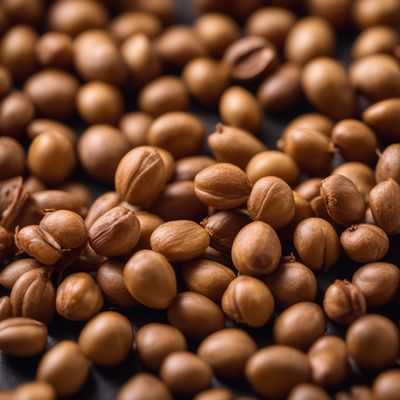
Ingredient
Bambara groundnut (dry seeds)
The Hidden Gem of Legumes
Bambara groundnut is a small, oval-shaped legume with a creamy white or light brown skin. It has a nutty flavor and a slightly starchy texture, making it a great addition to soups, stews, and salads. These dry seeds are rich in protein, fiber, and essential minerals.
Origins and history
Bambara groundnut has been cultivated in Africa for thousands of years and is believed to have originated in West Africa. It has played a significant role in the diets of many African communities, providing a sustainable source of nutrition. Today, it is still widely consumed in various African countries and is gaining popularity in other parts of the world.
Nutritional information
Bambara groundnut is a nutrient-dense ingredient, packed with protein, dietary fiber, iron, magnesium, and phosphorus. It is also low in fat and contains no cholesterol. A 100-gram serving provides approximately 360 calories.
How to select
When selecting Bambara groundnut, look for dry seeds that are uniform in size and free from cracks or discoloration. Avoid any seeds that appear moldy or have a rancid smell. Opt for packaged seeds that are stored in a cool, dry place to ensure freshness.
Storage recommendations
To maintain the freshness of Bambara groundnut, store it in an airtight container in a cool, dry place. It can be kept for up to a year. If the seeds are shelled, store them in the refrigerator to extend their shelf life.
How to produce
Bambara groundnut can be grown in warm climates with well-drained soil. It requires a long growing season and is typically sown directly into the ground. Regular watering and weeding are necessary for optimal growth. Harvest the pods when they turn brown and dry them in a well-ventilated area before removing the seeds.
Preparation tips
Bambara groundnut can be boiled, roasted, or ground into flour. Boiled Bambara groundnut can be enjoyed as a snack or added to soups and stews. Roasted seeds can be used as a topping for salads or ground into a paste for sauces and spreads. The flour can be used as a gluten-free alternative in baking recipes. Before cooking, it is recommended to soak the seeds overnight to reduce cooking time and improve digestibility.
Culinary uses
Bambara groundnut is commonly used in African cuisine, particularly in dishes like groundnut soup, maafe (peanut stew), and akara (fried bean cakes). It can also be added to salads, stir-fries, and grain bowls for an extra protein boost and nutty flavor.
Availability
Bambara groundnut is primarily cultivated in various African countries, including Nigeria, Ghana, Mali, and Burkina Faso. It is also grown in parts of Asia, such as India and Indonesia. It is less commonly available in other regions of the world.
More ingredients from this category

Tepary bean (dry seeds)
The Ancient Bean of the Desert

Black gram (dry seeds)
The Mighty Black Gram: A Nutrient-Packed Legume

Horse gram (dry seeds)
The Nutritional Powerhouse: Horse Gram

Mat bean (dry seeds)
The Mighty Mat Bean: A Protein-Packed Legume

Kersting's groundnut (dry seeds)
The Nutty Delight: Exploring the World of Kersting's Groundnut